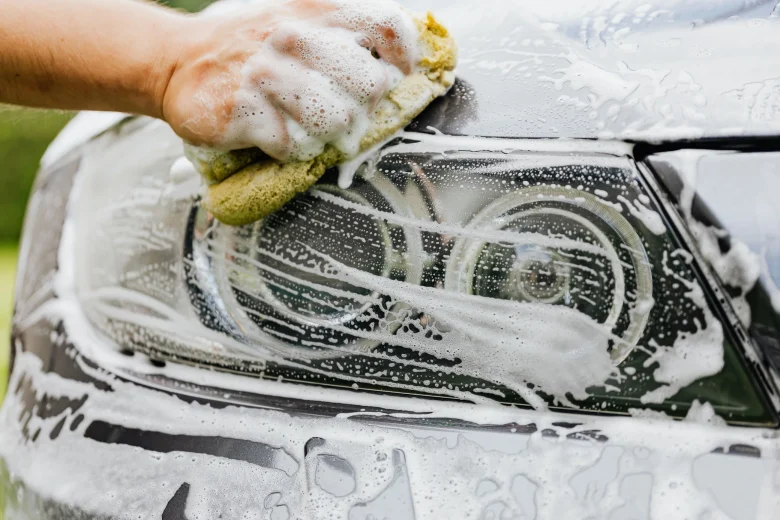With a little imagination, getting your car squeaky clean with very little deep scratches and swirl marks is entirely possible. To get started, consider this advice:
Always make sure to have all needed supplies on hand. It’s a smart idea to keep a spray detailer in the trunk to help with cleaning in between washes. Then, always make sure the proper washing and drying methods are used to achieve gloss without streaks.
Use the Two-Bucket Method
A big part of a driver’s daily life, professional or DIY detailing work, is maintaining a vehicle’s shine. The paint must always be protected, and the bodywork should not be damaged due to improper techniques over the years. All of this keeps your pride and joy looking its best for a while.
The Two-Bucket Method is likely the simplest approach to achieving that scratch-free wash on your car: when washing a car, you can accomplish the highest results with the lowest effort by using this technique, which two buckets filled with soapy water, and the other one is rinse water. Then, each bucket will be used to prevent the dirt picked from one bucket from being put back onto your car and risking scratches.
Begin by filling one bucket with soapy water while another bucket remains with clean water. Then, submerge the wash mitt into the clean water and rinse it often as you work. This process helps remove any dirt from wheels that, if not extracted from the wash mitt, can potentially damage the paintwork on your vehicle.
After washing your car, applying wax will help repulse dirt while preserving the streak-free shine between the washes. Additionally, carrying a spray detailer with a microfiber cloth to quickly clean the bird droppings, dust, or any unwanted debris is also a great idea.
Use the right soap
When using a foam cannon or a pressure washer, the soap chosen for the car becomes very important consideration. This is specifically important when doing car wash with thick foam that sticks onto the car’s surface. Soap for these appliances is specially formulated for these appliances, and such soaps contain thick foam that loosens and wipes away car grime without streaking.
Change up the type of cleaner you wash your car with. Household cleaners like dish soap have harmful components that may strip paint protection layers and have a lower cleaning efficiency compared to specialized automotive soap.
When buying car wash soap, always check the manufacturer’s instructions regarding dilution ratios. Too much soap may cause residue buildup that dulls the car’s shine, whilst too little soap fails to properly clean the vehicle. It is also wise to avoid washing the car under direct sunlight so the soap does not dry too quickly and cause streaks.
Use phosphate free and biodegradable soaps to minimize pollution to local waterways or the environment. Also, make sure to pour the rinse buckets into a sink or toilet instead of the storm drain to reduce the amount of wastewater that pollutes local water bodies.
Employ Microfiber Towels
The unique features of microfiber towels make them incredibly useful for cleaning, as they can absorb liquid and lift dirt without scratch surfaces. Depending on the intended task, a multitude of cloths, from car dusting and polishing to full car washes, are available in different sizes, weaves, and textures. Ensure you purchase adequate quantity of microfiber cloths so you can comfortably cover all surfaces in your car.
Bear in mind that wheels have small dirt and rocks, therefore when cleaning them, separate soapy water that is used on body of the car is needed, otherwise the mixing could cause scratches to the paintwork. A soft bristled wheel brush would help for thorough cleaning in tight places around wheels and tire wells.
In this last stage, your vehicle has to be dried completely. A waffle-weave towel is ideal for drying and will help in getting rid of the remaining traces of cleaner. Moreover, it will help glass surfaces like mirrors and windows to be completely free of streaks due to its special weave.
Microfiber cloths can be put through the wash many times without destroying their fibers, however, special care should be taken not to over wash them. Hot water, any form of fabric softener, bleach, or anything that harms the fibers should be evaded as this would damage them, making them less useful in the future. Air drying is preferred to tumble drying because it reduces the accumulation of lint while making them more efficient and economical for later use.
Don’t Forget the Tires
The wheels and tires of your automobile tend to pick up brake dust, mud, and any road dirt that gets thrown onto them over time. If these contaminants are left unchecked, not only do they make your tires look dirty, but they are also able to roughen up rubber components which would cause them to prematurely wear down. Each time you make a DIY car wash attempt, it is very important that every detail is washed out completely- this goes for your wheels and tires too!
It is recommended, however, that for proper tire and rim care you use a dedicated tire cleaner. This removes the chances of damaging the finish on your vehicle, or even worse, creating water spots on the paint after it has been dried. A dedicated cleaner helps to ensure appropriate tire and rim care, minimizing the chances of damage to finish and paint, while also preventing further instances of water spots after drying has taken place.
Initially, assemble all tools needed for washing the car. It is advisable to have an environmentally friendly products, specialized sponge or wash mitt, and two buckets containing soapy and rinse water set aside; have a microfiber towel within reach to prevent water spots from forming; and remember to pat dry rather than wipe to avoid surface scratches that are difficult to fix afterwards.




